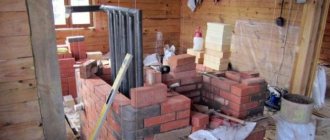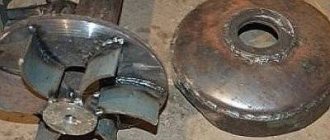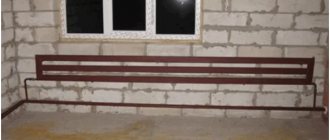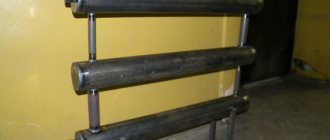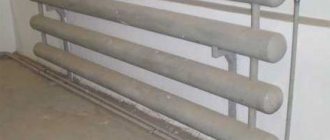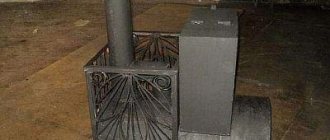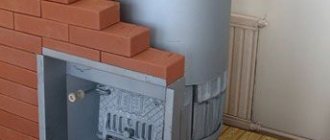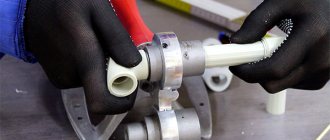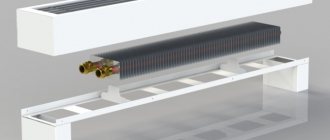In private houses there are always several utility or technical rooms, where the requirements for the interior are low. But you still need to heat them, and in order not to spend money on buying modern radiators, you can install a steel register welded from pipes there. And, although everyone has seen such simple heating devices with their own eyes, not everyone knows their structure. This material is to help those homeowners who want to independently manufacture, install and connect heating registers to their system.
Steel pipe register
Key Features
The register is several parallel pipes held by vertical jumpers.
To construct a heating system, steel or cast iron products of round or rectangular cross-section are used. The layout of the elements is sectional or serpentine. The coil is a classic design with efficient heat transfer. In sectional registers, transitions are made close to the edge to increase the heat transfer rate.
Heating structures can be portable (contain heating elements that heat water) or stationary (connected to the boiler). The coolant moves from top to bottom. The pipes can be connected to the pipe by threaded connection or welding. Additional jumpers make the structure more rigid.
To heat 1 m2 you need 1 m of pipe with a diameter of 60 mm.
- ease of connecting the heat exchanger to the system;
- the ability to manufacture a structure according to specified parameters;
- The coolant can be water or steam.
Calculation of a heating structure made of round pipes
This calculation technique is not suitable for finned registers, since they have a larger surface area and heat transfer. Specific thermal power is calculated using the formula:
where Δt is the temperature difference between the air and the working medium of the pipe, K is the thermal conductivity coefficient (for metal it is equal to 11.63 W/m²*C), L is the length of one section, D is the diameter of the pipe, P is the number P = 3.14 .
When calculating the remaining sections, the resulting value is multiplied by a factor of 0.9.
Calculation of heating registers
To prevent the house from being cold and the heating to evenly warm all rooms, it is important to calculate the number of registers for each room. For purchased devices, their power is looked at in the passport and the number of devices is calculated; for homemade tubular heaters, the length of the pipes will have to be determined by yourself
Calculation of the required thermal power to heat the room
If your house is built according to a project, then data on the required power of heating devices is available in the documents - you need to find and use them.
If there is no design of engineering systems, then use traditional approximate data on heat loss:
- 100 W per 1 m² of room area with one external wall and one window.
- 120 W per 1 m² of room area with two external walls and one window.
- 130 W per 1 m² of room area with two external walls and two windows.
The total heat losses are calculated, the resulting power is increased by 20% (multiplied by 1.2) and the total power of all heating devices is obtained. In the northern regions of Russia, it is desirable to increase the resulting power by another 20 percent.
The power of the appliances in each room is calculated based on the above data (heat loss in the room multiplied by 1.2).
The exact method for calculating the heat loss of a house is very complex and is used by design organizations.
Calculation of register thermal power
The amount of heat (W) supplied from the pipe to the room is determined by the formula:
Where:
- K is the heat transfer coefficient, W/(m2 0С), taken depending on the pipe material and coolant parameters.
- F is the surface area, m2, calculated as the product of π·d·l.
- where π = 3.14, and d and l are the diameter and length of the pipe, respectively, m.
∆t – temperature difference, 0С, determined in turn by the formula:
- Where: t1 and t2 are the temperatures at the inlet and outlet of the boiler, respectively.
- tk is the temperature in the heated room.
- 0.9 is a reduction factor for a multi-row device.
For a steel structure, the heat transfer coefficient to air is 11.3 W/(m2 0C). For a multi-row register, a reduction factor of 0.9 is accepted for each row.
For calculations, you can use a calculation calculator - there are many of them on the Internet, but manually is more reliable.
Heat transfer of registers made of smooth pipes. Table
The values of heat transfer coefficients for steel smooth-tube registers are given in the table.
In private homes, the temperature difference is usually 60-70 °C.
How to calculate the required number of register sections
The number of purchased registers is determined by dividing the required power by the rated power of the device.
For homemade registers, divide the required power in each room by the heat transfer of one linear meter of pipes used. The required total length of pipes is obtained. Then this length is distributed between the devices, divided by the number of pipes - their length is obtained. There are options here - there may be several short devices or one long one.
What other parameters should be taken into account
If there is a need to increase the power of the device, then it is necessary to increase the length of the pipes, and not their diameter. The efficiency of the system decreases with increasing pipe diameter.
If the system uses oil or antifreeze, it should be noted that they have a lower heat capacity than water. When using them, heating devices must have a larger area than devices in a water system.
How to make a register with your own hands
To make a homemade heating register from pipes, you will need 3 profile pipes of rectangular section 60x80 mm and a wall thickness of 3 mm, as well as 4 round pipes with a diameter of 25 mm, plugs made of sheet material with a wall thickness of 3 mm.
- Holes for jumpers are measured and cut at the ends of the pipes. The central pipe is cut through on both sides.
- Lay out the profile pipes horizontally, lay jumpers between them strictly along the holes, then weld them.
- Now the product is installed vertically.
- Welded seams create tightness at pressures up to 13 atm.
Video: register installation procedure
Heat exchanger for bath
In the sauna, the energy of the stove is transferred to water. The curved pipe is placed inside the firebox, while the coil does not come into contact with the fire. As hot water rises, cold water replaces it. In a closed water circuit, a cycle occurs that increases the temperature in the entire system. The bath coil is made of stainless steel; other materials do not withstand such harsh operating conditions.
Craftsmen lay out the furnace, building a heat exchanger (register) inside it, which is then connected to a water tank. The optimal way to place the heat exchanger is opposite the opening through which flue gases flow into the smoke duct. The register design is U-shaped and welded from pipes. Sometimes a finished section of a cast iron battery is used. Due to the low natural pressure, pipes with a diameter of 25 mm and a length of no more than 2.5-3 m are used.
The register dimensions are selected depending on the furnace power. To heat 100 liters of water, you will need a pipe 2 m long and 40 mm in diameter. The thermal power of such a heat exchanger will be equal to 2 kW.
- It is better to install the heat exchanger simultaneously with the laying of the furnace after the foundation has been erected. In this case, the size of the firebox is easy to match with the size of the register.
- A distance of 10-15 mm is maintained between the heat exchanger pipes and the firebox. The coil does not come into contact with the flame; it is heated by the hot air. The curved pipe is connected to the tank through threaded connections.
- A curved pipe wound around a metal chimney can also heat water (the outlet temperature reaches 500 C).
- Experts use heat-resistant seals at the junction of the heat exchanger and water pipes.
- Heavy welded structures are installed in brick kilns (it is difficult to find a place for it in an iron kiln).
- The chimney of a stove with a heat exchanger is cleaned more often, since an order of magnitude more soot is formed in it due to incomplete combustion of fuel.
- To heat the liquid even faster, a circulation pump is introduced into the system to artificially move water.
- The heat exchanger is filled with cold water before the oven heats up.
- In order to prevent pipes from bursting at sub-zero temperatures, it is necessary to provide for the possibility of completely draining water from the system.
A self-made register is a good opportunity to save money. Heat exchangers made of smooth or profiled products can withstand pressure and temperature surges, and their high heat transfer allows them to be used for heating large rooms.
For the heating system of large premises, it is not advisable to use conventional factory batteries and radiators. They have very little heat output and power. As an alternative, heating registers can be considered.
Heating devices called registers are several folding pipes located parallel to each other and connected to each other by jumpers. The coolant moves through the pipes, transferring heat to the iron walls of the register, which heat the air space in the room.
Water or antifreeze can be used as a coolant , which prevents the pipes of a disconnected system from freezing during the cool season. In independent heating registers with a cylindrical electric heater (TEH), the coolant can also be oil, then the independent register is considered the most powerful analogue of domestic oil radiators. They have become widespread due to their simplicity of design, reliability and a number of other advantages.
Calculation of heat output of a heating register
A heating register made of four smooth pipes and a flow diagram of the coolant are shown in the figure.
The diagram clearly shows how the coolant moves inside the heating register. In order to maintain certain temperature conditions in the premises and comply with SNIPs, it is necessary to calculate the heat transfer of the heating register. To carry out heat transfer calculations, you will need to download the Excel file to your computer.
Let's take a closer look at how to use the specified file to obtain results on the heat transfer of heating registers.
Initial data that may be required for calculation:
There is not a lot of initial data, they are clear and simple.
- Pipe diameter D in mm is entered
to cell D3: 108.0
- We write down the length of the register (one pipe) L in m
to cell D4: 1,250
- We write the number of pipes in the register N in pieces
to cell D5: 4
- We enter the “supply” water temperature tsw °C
to cell D6: 85
- We write the water temperature at the “return” °C
to cell D7: 60
- Enter the room air temperature tвв °C
to cell D8: 18
- Select the type of outer surface of the pipes from the drop-down list
in merged cells C9D9E9: “In theoretical calculation”
- We enter the Stefan-Boltzmann constant C in W/(m2*K4)
to cell D10: 0.00000005669
- We enter the value of free fall acceleration g in m/s2
to cell D11: 9.80665
By changing the initial data, you can simulate any “temperature situation” for any standard size of the heating register!
The heat transfer of just a single horizontal pipe can also be easily calculated using this program! To do this, it is enough to indicate the number of pipes in the heating register equal to one (N=1).
Results obtained when calculating heat transfer and their interpretation
- The degree of emissivity of the radiating surfaces of pipes ε is automatically determined by the selected type of outer surface
in cell D13: =INDEX(H5:H31,G2) =0.810
In the database, located on the same sheet with the calculation program, 27 types of external surfaces of pipes and their degree of emissivity are presented for selection. (See the download file at the end of the article.)
- We calculate the average temperature of the pipe walls tst in °C
in cell D14: =(D6+D7)/2 =72.5
tst=(tp+to)/2
- Calculate temperature difference dt in °C
in cell D15: =D14-D8 =54.5
dt=tst— tv
- The coefficient of volumetric expansion of air β in 1/K is determined
in cell D16: =1/(D8+273) =0.003436
β=1/(tв+273)
- We calculate the kinematic viscosity of air ν in m2/s
in cell D17: =0.0000000001192*D8^2+0.000000086895*D8+0.000013306 =0.00001491
ν=0.0000000001192*tв2+0.000000086895*tв+0.000013306
- Prandtl criterion Pr is determined
in cell D18: =0.00000073*D8^2-0.00028085*D8+0.70934 =0.7045
Pr=0.00000073*tv2-0.00028085*tv +0.70934
- 16. Calculate the thermal conductivity coefficient of air λ
in cell D19: =-0.000000022042*D8^2+0.0000793717*D8+0.0243834 =0.02580
λ=-0.000000022042*tв2+0.0000793717*tв+0.0243834
- The area of heat-transferring surfaces of register A pipes in m2 is determined
in cell D20: =PI()*D3/1000*D4*D5 =1.6965
A=π*(D/1000)*L*N
- The heat flux of radiation from the surfaces of the pipes of the heating register Q and in W is calculated
in cell D21: =D10*D13*D20*((D14+273)^4- (D8+273)^4)*0.93^(D5-1) =444
Qi=C*ε*A*((tst+273)4— (tb+273)4)*0.93(N-1)
- We calculate the heat transfer coefficient for radiation αi in W/(m2*K)
in cell D22: =D21/(D15*D20) =4.8
αi=Qi/(dt*A)
- Grashof criterion Gr is calculated
in cell D23: =D11*D16*(D3/1000)^3*D15/D17^2 =10410000
Gr=g*β*(D/1000)3*dt/ν2
- We find the Nusselt criterion Nu
in cell D24: =0.5*(D23*D18)^0.25 =26.0194
Nu=0.5*(Gr*Pr)0.25
- We calculate the convective component of the heat flow Qк in W
in cell D25: =D26*D20*D15 =462
Qк=αк*A*dt
- And the heat transfer coefficient during convection αk in W/(m2*K) is determined accordingly
in cell D26: =D24*D19/(D3/1000)*0.93^(D5-1) =5.0
αк=Nu*λ/(D/1000)*0.93(N-1)
- We calculate the total heat flow power of the heating register Q in W and Kcal/hour, respectively
in cell D27: =(D21+D25)/1000 =0.906
Q=(Qi+Qk)/1000
and in cell D28: =D27*0.85985 =0.779
Q'=Q*0.85985
- We find the heat transfer coefficient from the surfaces of the heating register to the air α in W/(m2*K) and Kcal/(hour*m2*K) respectively
in cell D29: =D22+D26 =9.8
α=αi+αk
and in cell D30: =D29*0.85985 =8.4
α'=α*0.85985
This completes the calculation in Excel. Heat transfer from the heating register from the pipes has been found!
The calculations have been repeatedly confirmed by practice!
Advantages and disadvantages of devices
Homemade metal or aluminum devices differ from conventional radiators in their dimensions. They consist of some pipes whose diameter exceeds 32 mm. To organize the circulation of the coolant, the pipes are connected to each other by pipes.
What is the reason for the popularity of these heat supply devices? First of all, the prospect of independent production. You can make bimetallic devices, metal or aluminum pipes.
Before connecting the heating registers, you should carefully study all their sides.
Advantages:
- Long service life. For metal and aluminum modifications it can reach 25 years. In this case, the possibility of breakdown will be minimal.
- Significant heat dissipation. This is due to the fact that the power of the devices exceeds this parameter of traditional radiators and batteries. Due to the large size of the coolant.
- Easy installation and operation. Since anyone who is at least a little familiar with the instructions for organizing heat supply can correctly identify the devices, they can be used in buildings of all types. But most often they can be found in the heating system of industrial, administrative and commercial premises.
Read also: Welding with flux-cored wire in a shielded gas environment
But, in addition to this, it is necessary to take into account the possible disadvantages that a register made of a smooth metal pipe may have:
- Large coolant size. This leads to its rapid cooling.
- Lowest rate of air convection. Reduces the efficiency of heat supply.
- Unsightly appearance. Most often this applies to homemade systems.
Correctly calculated heating heat transfer directly depends on the design of the device. Currently, a number of types of these heat supply devices are used, differing not only in the production material used, but also in appearance.
What are there
Heating registers are made of different materials and have different shapes. Each has pros and cons.
What are they made from?
If we talk about materials, the most common is steel, or rather electric-welded steel pipes. Steel does not have the best heat transfer, but this is compensated by its low price, ease of processing, availability and a large selection of standard sizes.
It is very rare to find pipes made of stainless steel - for decent power a large number of pipes are required, and you have an idea how much stainless steel products cost. If they did, it was probably a long time ago. They also use galvanized steel, but it is more difficult to work with - you won’t be able to cook it.
Registers made of copper pipes have high heat transfer and an equally high price
- Requires neutral and clean coolant, free of solid particles
- the presence of other metals and alloys in the system is undesirable, except for compatible ones - bronze, brass, nickel, chromium, therefore all fittings and fittings will need to be made from these materials;
- Careful grounding is mandatory - without it, in the presence of water, electrochemical corrosion processes begin;
- the softness of the material requires protection - we need screens, covers, etc.
There are registers made of cast iron. But they are too bulky. In addition, they have a very large mass; no less massive racks need to be made for them. Plus, cast iron is fragile - one blow and it can crack. It turns out that this type of registers also needs protective covers, and they reduce heat transfer and increase cost. Moreover, installing them is complex and hard work. The advantages include high reliability and chemical neutrality: this alloy does not care what coolant it works with.
Cast iron finned tube registers
In general, copper and cast iron are not easy. So it turns out that the optimal choice is steel registers.
Design Features
Heating registers are used to a greater extent in industrial workshops, technical rooms, and, in addition, in apartments and private houses. Registers are common in many places with high sanitary requirements, for example, in medical organizations and schools.
According to the type of system, heating registers are divided into collapsible and coil devices:
- In sectional registers, pipes are connected to each other by jumpers of the smallest diameter - this type of connection is determined mainly by the ease of installation. The distance between the register pipes is calculated using the formula D+50 mm, where D is the pipe diameter. If the rule is followed, mutual irradiation of the pipes will be minimized, as a result, heat transfer increases.
- In coil-type registers, pipes are combined from the end using an outlet whose diameter is equal to the diameter of the pipes. The slight increase in the cost of the product is offset by the huge surface area, and as a result, by the greater efficiency of the heating device. In addition, the coil register has less hydraulic resistance than the sectional one, which makes it possible to use less powerful, but more economical and cheaper pumps in the heating system.
Pipe end caps can be either thin, convex or elliptical. It is recommended to use such plugs in systems with the highest coolant pressure, and, in addition, for decorating purposes, in order to add the most interesting appearance to the device. If necessary, the outer sector of the register is additionally equipped with a fitting for a degassing valve.
There is another variation - an independent register with a heating element . Equipment of this type does not require connection to a heating system, since the coolant is heated by electricity using an integrated heating element. During the design of such registers, the power of the heating element is selected according to the section of the device plane: overheating can provoke an excessive increase and leakage of coolant through the emergency valve. With low power of the heating element, the efficiency of the device will be lower than its possible capabilities.
The outer segment of the independent register is integrally equipped with a fitting, which is initially used to fill the coolant inside, and then used to connect an emergency valve or expansion tank - and in this case it is used to compensate for the expansion of the coolant during heating.
Materials for production
The materials used for the production of registers are VGP pipes and electric-welded steel pipes (according to GOST 10704−91 and others). The alloy has absolutely all the data needed for heating devices: resistance to high temperatures and pressure, the smallest thermal increase (in the established temperature range), significant thermal conductivity, shock resistance (which is important when used in industrial premises), and a long period of operation in heating systems.
In order to ensure the quality of welding and the reliability of the seams, the finished heating registers are subjected to pressing and hydraulic tests. The pointer is filled with liquid, and excess pressure is reached, usually 1.6 MPa. If a leak is detected, the liquid is combined, the detected holes are welded, after which the process is repeated.
Calculation
There are methods for calculating the characteristics of heating devices. They are distinguished by the accuracy of their calculations. However, to organize heat supply with the support of metal or aluminum heating registers, it is recommended to seek the services of specialists. Another option is to use special software .
However, in some cases it is necessary to properly think through the heating device yourself. To do this, you can use a simple diagram. You should first know the following characteristics:
- The general area of the heated building.
- The heat transfer coefficient of the register material used.
- Diameter of pipes used for manufacturing
Knowing the characteristics, you can calculate the power of the device.
Calculation of registers made of smooth pipes , their quantity and parameters required for heating a particular building can only be carried out approximately with a significant degree of error. This is explained by a large number of conditions on which the temperature in the room depends, such as: wall thickness, the thermal insulation properties of the room, the number and area of openings (and, in addition, the total area of the cracks in them), ventilation intensity, outside air temperature, wind speed.
Therefore, it is more correct to plan the number of parts in the registers and the number of heating devices themselves “with a reserve”, and you can control the temperature in the room by changing the operating modes of the heating boiler. However, there is an unofficial standard: for heating 1 sq. meter of a building with a ceiling height of 3 meters requires 1 meter of pipe with a diameter of 60 mm.
Connection
Connecting devices to the heating system can be done using welding, threaded and flange connections - the selection of one or another type of connection depends on the useful features of the heating system. If the device consists of a significant number of parts and pipes of larger diameter, it is important to use stands and fasteners that support the register not only at the bottom, but also in the middle, in order to share the weight and not form an excessive load on the lower sector. Please note that for best performance, it is preferable to install the register closer to the floor.
How to install
There are two installation options: hang it on the wall or put it on a stand. The choice depends on the dimensions and weight of the resulting structure, as well as on the type of walls.
Quite often they do a combined installation: they weld racks, which are then attached to the wall. Even very massive registers can be installed in this way. This installation option also provides a high level of security.
Each such heating device must have an air vent at the top point. It is needed to bleed air from the system.
DIY making
One of the advantages of using registers in heating systems is the possibility of their independent production. For this purpose, round metal pipes are most often used. Despite the fact that the heat transfer coefficient of the heating register in this case will not be perfect, the production process will not require special skills.
To make this heating element yourself, you will need a pipe with a diameter of 40 to 70 mm. The largest cross-sectional value will lead to significant heat losses during coolant circulation.
make a heating device with your own hands according to the following work plan:
- Calculation of the optimal characteristics of the heating device - pipe diameter, total length of the section.
- Formation of a drawing to calculate the optimal amount of material used.
- Carrying out work on the production of a heating register.
- Checking the structure for leaks.
Read also: Diagnostics of the generator voltage regulator
To accomplish this task, you will need a steel pipe specialized for forming the main registers and a line of the smallest diameter. With its help, heating devices will be combined with each other and the heating system. In addition, special end caps for the pipes will be required.
At the first stage , use a grinder to cut the pipes to the required length. It is not recommended to use a welding machine for this, since a weld will form at the ends of the heating register from the convex pipe.
Then holes are made to connect the pipes. The pipes are welded using a welding machine and end caps are installed. To ensure safe operation, the air vent and bleed valve must be identified. They are installed at the top of the system, but on the opposite side relative to the place of connection to the heating.
In some cases, improvements are made to the traditional design of a steel or bimetallic register. It consists of installing an electric heating element. A homemade heating device will produce heat using a heating element. But for this, it is necessary to determine the shut-off valves during installation so that the coolant can circulate only inside the heating device. This makes a good source of heat.
Correct installation of heating devices can be carried out in 2 ways - using threaded connections or using a welding machine. It all depends on the single mass of the structure, its dimensions and the characteristics of the heat supply system. In general, experts advise following the same instructions as when installing radiators.
Heating devices are an essential element of any water heating system. They are usually the most expensive part. A good opportunity to save money would be to use homemade radiators. They are made from smooth round steel pipes or from profile pipes. The latter option is somewhat more expensive, but allows you to reduce the depth of the device and get a more aesthetic appearance.
The use of a profile pipe for the manufacture of heating registers has a number of features. When starting to work with your own hands or deciding to buy a “homemade” product, you need to carefully weigh the pros and cons. Studying the basic rules by which heating registers are made from a profile pipe will help you avoid mistakes when working independently and will make it possible to make a competent choice of the necessary parameters.
Design of heating registers
Heating devices in the form of registers are a structure of several vertical or horizontal pipelines connected to each other using jumpers. In this case, the connecting elements can have different shapes and sizes. Depending on their location, classification is performed.
Register structure
For the manufacture of heating registers, smooth carbon steel pipes with a round cross-section, as well as square and rectangular ones, are used. Their combined use is possible. Stainless and galvanized steel, aluminum, copper, and brass can also be good materials for registers, but they are much more expensive and more difficult to process with your own hands.
Heating registers made of steel profile pipes are considered the simplest to make. They can be made in two main configurations: sectional type and coil type (S-shaped).
In a sectional type register, several sections of profiled metal with capped ends are arranged in parallel and connected to each other by round tubes of smaller cross-section. The jumpers ensure that the rows of the device are filled with coolant from both sides simultaneously. Moreover, the closer to the edge the transition pipes are installed, the higher the heat transfer of the device.
In a coil register, the liquid passes in an S-shape through rows of profile pipes, gradually cooling. To add rigidity to the structure, additional blind jumpers are used. Horizontal rows are connected in pairs by a snake using tubes of a smaller cross-section, like in sectional models, or sections of the main profile. The latter option is preferable due to lower hydraulic resistance and greater heat transfer.
Connecting pipes are made with threads or welding. The most effective option for connecting a heating device is a top-down diagram. For low models and in the case of forced circulation of coolant, entry and exit from below may be justified.
The design of the register must include a Mayevsky valve or an automatic air vent. It is located at the end of the top row on a threaded fitting to allow replacement. A prerequisite for installation is to maintain a slope of 0.05% in the direction of coolant movement.
Registers can be either stationary or portable. The former work as elements of a general heating system, the latter perform the task of local heating. The heat source for a separate mobile register is a heating element with a power of 1.5-6 W, mounted in the housing.
Important! The distance between register rows significantly affects heat transfer. The closer the pipes are to each other, the greater their mutual influence, which reduces the efficiency of the device. It is recommended to place the rows at a distance of at least the height of the profile pipe, increased by 50 mm.
In addition to large horizontal registers, small vertical models are also in demand. If you carry out the work carefully, you can get homemade cheap heating radiators from profile pipes that are almost as aesthetically pleasing as modern sectional radiators.
In some cases, steel registers can be a good addition to the heating units already installed in the room. Despite the lower heat transfer than radiators of a similar size, their use may be more appropriate due to their lower cost.
High vertical registers are very convenient for high rooms or near high window openings. They can successfully fit into the interiors of rooms with unusual design solutions. By experimenting a little with color and shape, you can get a creative decoration from simple heating devices.
Advantages and disadvantages of profile pipe
Most often, heating registers are made from smooth round-section water and gas pipes. They are cheaper, have better hydraulic characteristics for transporting coolant, and greater tensile strength with a small wall thickness. What is the reason for the use of profile pipes for the manufacture of registers?
Heating radiators made from rolled metal of square and rectangular cross-section have a number of important advantages:
- compactness of the device in depth;
- the ability to give an attractive appearance;
- the surface area is greater than that of a round pipe of the same height;
- additional opportunities for creative design of non-standard premises;
- They are relatively easy to make with your own hands and do not rotate during operation;
- can be made from pipe scraps left over after construction work.
However, there are also plenty of disadvantages:
- the profile pipe is not intended for transporting liquid;
- lower resistance to water hammer and high pressure;
- The length of the welds is longer than that of similar round pipe registers, which increases the likelihood of leaks and reduces the overall reliability of the device.
Read also: Marking of Bosch jigsaw files
Thus, before deciding on the advisability of using registers made of profile pipes, you should evaluate all possible options, carefully analyze the operating conditions and the requirements that heating devices must meet in each specific case.
Selecting parameters
The heating register parameters are determined based on the required heat output. The most accurate values are provided by a detailed thermal engineering calculation of heat loss through the building envelope, but since it is quite labor-intensive, we will consider alternative options.
Very approximately, for a typical insulated room with a height of no more than 3 m, you can take 1 kW of thermal power per 10 m 2. More accurate values can be determined from the table below, depending on the quality of thermal insulation and the volume of the room.
Q=K ·F · ∆t,
K – heat transfer coefficient, W/(m 2 0 C) , for a single pipe K = 11.3 W/( m 2 0 C );
F – pipe surface area, m 2, F = 2· (a+b) · l ,
where a and b are the dimensions of the cross-sectional sides, and l is the length of the pipe, respectively, m;
∆t – temperature difference, 0 C, ∆t= 0.5·(t1 + t2) – tк ,
where t1 and t2 are the coolant temperatures at the inlet and outlet of the device; tk – temperature in the room.
The required pipe length is calculated by dividing the required thermal power by the heat output of 1 m of pipe. The number of rows is determined by rounding up and is determined by the availability of free space and the configuration of the room. For the obtained number, the heat transfer value is specified taking into account the mutual irradiation of the pipes using a reduction factor of 0.9 for each row.
The length of the register can be taken structurally, taking into account the characteristics of the room and the location of the equipment. For example, if there is a large window, then it is desirable that the length of the threads be no less than the size of the window, creating a wide thermal curtain for cold air.
Advice! In some cases, it makes sense to take the length of the register across the entire width of the room. This will ensure the most even heating of the room. For objects such as greenhouses, this is especially important.
The cross-section of the profile pipe is taken either based on the available material, or is selected by trial calculations and finding the optimal combination of cross-section and length of rows of the heating register. The most commonly used pipes are 60*40, 60*60 and 80*60 with a wall thickness of 3 mm. Large cross sections are not desirable, since the increased volume of coolant will create additional load on the boiler.
Note: it is better not to skimp on wall thickness. The thicker the pipe wall, the longer the heating device will last. It will be able to withstand large pressure surges and is more resistant to corrosion.
Based on the calculations carried out, the final selection of heating register parameters is made and a drawing is drawn up. According to the accepted dimensions, a heating device is ordered or the register is made by hand.
Selecting a heating device configuration
Homemade radiator designs are mainly made on the basis of metal pipes with a diameter of 80 - 150 mm.
Design features are limited to two versions:
- Lattice.
- Snake.
The lattice design of the heating battery differs from the “snake” in a slightly different circuit design, and, depending on the variations in such batteries, the distribution of the coolant may be different.
Options for circuit design of heating registers for their own production: 1 – one jumper and one-sided power supply; 2 – two jumpers and one-sided power supply; 3 – two-way power supply and 2 jumpers; 4 – two-way power supply and 4 jumpers; 5, 6 – multi-pipe
Coil structures actually have a monotonous design, implying strictly sequential movement of the coolant.
Lattice registers are constructed according to different schematics:
- with one or two jumpers and one-way power supply;
- with one or two jumpers and versatile power supply;
- parallel connection of pipes;
- sequential connection of pipes.
The number of pipes in one assembly can range from two to four or more. Rarely, there is also the practice of making single-pipe registers.
A coil assembly usually contains at least two pipes connected on one side by a blind jumper and on the other by a through jumper, which are made from two pipe bends (2x45º). It should be noted that the design of heating registers in the form of a coil is used much less frequently than “grid” designs.
Options for the possible manufacture of “snake” type registers. For coil-type register battery designs, the choice of manufacturing options is limited compared to lattice-type designs.
Both manufacturing options - lattice and coil - can be made not only on the basis of classic round pipes, but also on the basis of profile pipes.
Profile pipes seem to be a somewhat specific material, since they require a slightly different approach when assembling heating radiators. However, registers made from a profile pipe are more compact and take up less usable space, and this factor is also important.
Making registers yourself
Steel registers have a fairly simple design and do not require much skill to create. Almost any person who has experience working with a welding machine can make homemade heating radiators from a profile pipe. Unlike round ones, they are conveniently fixed in place, which makes welding easier.
Required materials and tools
Before starting work, you need to stock up on everything you need. Let us consider in detail what is required for the simplest three-row register.
- Profile pipe in accordance with the design parameters. Dimensions can be from 30x30x3 to 80x80x3 mm.
- A round pipe with the same wall thickness with a diameter of 25 or 32 mm depending on the cross-section of the profile pipe.
- Steel sheet 3 mm thick.
- Branch pipes with external or internal threads in accordance with the diameter and type of connection – 2 pcs.
- Steel coupling with internal thread with a diameter of 15 mm and Mayevsky tap.
- Welding machine.
- Drill.
- Bulgarian.
- Hammer.
- Marker or metal rod.
- Roulette.
- The profile pipe is cut into pieces of the required length in accordance with the drawing.
- The round pipe is cut into 4 pieces of 10 cm each.
- 6 plugs are cut from sheet metal in accordance with the size and shape of the profile pipe. They should be 3-5 mm smaller than the cross-section of the pipe. This will allow you to neatly hide the weld in the gap.
- The pipes are laid on a flat horizontal surface strictly parallel at a distance of 10 cm. You can use two wooden beams for support. The ends are aligned in one line. Marks are made for the holes at a distance of about 5-10 cm from the edge.
- Using a cutter or drill, the intended holes are cut in accordance with the diameter of the jumpers.
Work order
- The jumpers are fixed in place and secured by welding at 2-3 points.
- Having positioned the structure vertically, the jumpers are finally welded. It is recommended to first make a thin seam at low current, which will allow the gaps to be filled well. Next, a thick main seam is performed at increased current.
- The internal space of the register is cleared of metal debris and slag.
- The plugs are applied, tacked and welded to the ends of the profile pipes.
- Welding seams are processed. The protruding parts are knocked down with a hammer, then each seam is cleaned with a grinder.
- Holes in the register are drilled depending on the selected connection diagram. In this case, it is better to place them not in the center of the ends, but slightly higher or lower.
- Connecting pipes are welded to the holes.
- The seams are cleaned and all holes except one are plugged. The register is filled with water under pressure and the welding quality is checked. The seams must withstand pressure up to 13 atm.
- The outer surface is cleaned, degreased and painted with heat-resistant paint.
- A fitting is welded to the top row and a Mayevsky valve is installed.
Sometimes supports are welded to the register, but devices without them are more versatile. If necessary, you can always use a stand, but the weight is less and you can still mount it on the wall.
